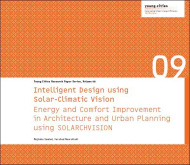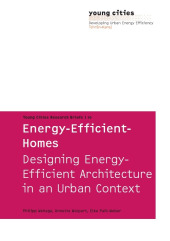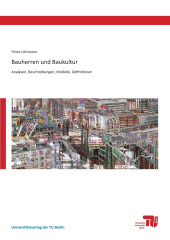Intelligent Design using Solar-Climatic Vision

Format: 26,0 x 22,6 cm
Publishing year: 2014
Thanks to the availability of energy, materials and technologies, the level of comfort in buildings is increasing around the world. However, today we are also facing buildings and cities that are responsible for a high percentage of global energy consumption. Pollution, heat island effect, climate change and global warming are just a few of the challenges that the human race, as well as other living matter on earth, will have to deal with in future. Moreover, as time goes by, we may not necessarily live in healthier conditions with better life styles. Within a limited period, this global and complex situation will need thorough, integrated and local surgery. This book is designed to draw greater attention to the sun and how a solar-climatic vision can influence and improve architectural design and urban planning. It may not have been discovered yet how small our planet is and how big the effect of a simple decision can be, but it is nevertheless important to be reminded of the sun not only as a powerful and perpetual actor in our dynamic atmosphere but also as a basis for figuring out a variety of adaptive solutions that must be identified and followed. In addition to the changes made by architects, clients and builders as well as planners, municipalities and all other persons who make decisions on plans, the role of those who live inside buildings and cities, not as users, but as producers and maintainers, also bear a certain degree of responsibility. Therefore, the optimization of new constructions, the modification of existing buildings and urban fabric should be considered on a global scale in regard to the sun as well as our future needs. The aim should be to improve energy-efficiency, health, comfort and safety in all living spaces, whether indoors or outdoors. In this respect, the analysis of the current situation, forecasting future scenarios and the development of intelligent alternatives are fundamental steps. In terms of energy efficiency, daylight provision and internal comfort, the use of advanced building materials and technologies as well as simulation tools can improve the building envelope and its performance. However, it is important to understand when, where and how they should best be applied to achieve an intelligent form as well as a responsive layout with a high level of performance for other essential aspects, too (e.g. structure, view, operation). Although today many consider “solar architecture” the attaching of solar thermal collectors and PVs to building roofs and facades, this is only one of the complex tasks which should be integrated in the design. In fact, solar architecture incorporates all the complexities of architecture on different scales. Besides, it has to respond accurately to certain issues resulting from the currently low price of other energy sources in many locations. In addition to the reduction of payments, other valuable improvements associated with solar-climatic considerations in the design should be clarified and compared. During the design process, an optimization (i.e. re-arrangement, re-orientation, re-sizing) of different elements, namely solar surfaces (i.e. transparent/opaque surfaces, shading/reflecting devices, collectors), building volumes and trees, does not necessarily increase the construction costs but can help identify deficient or over-designed elements. Alongside improving the energy efficiency aspects of individual buildings, a solar-climatic vision in planning can lead to other qualities for the benefit of small and large-scale living spaces, whether indoors or outdoors. Around the world, we must be prepared for more shocking news and annual records if many continue to build buildings, whether cheap or expensive, with little attention to the sun. In neighborhoods on an urban scale, the insufficient analysis and inaccurate decisions regarding building volumes and orientation can affect the potentials and performance of both internal and external spaces in terms of energy production, energy demand, daylight, health, comfort and safety for long periods of time. This book includes a decade of SOLARCHVISION practices on how architectural design and urban planning can be adapted by the constant path and variable effects of the sun in each location. Sharing such a vision can help architects, urban planners and clients to make more accurate decisions concerning energy and climate-related matters. After presenting fundamental diagrams in different cities around the world (e.g. the sun paths, solar radiation and temperature models), the role of an intelligent design for the building skin is described and analyzed in terms of finding a good relation between outside and inside as well as the direct and indirect collection of solar energy on different building surfaces. This research can bring about new appearances and structures for the creation of smart buildings and responsive cities.



